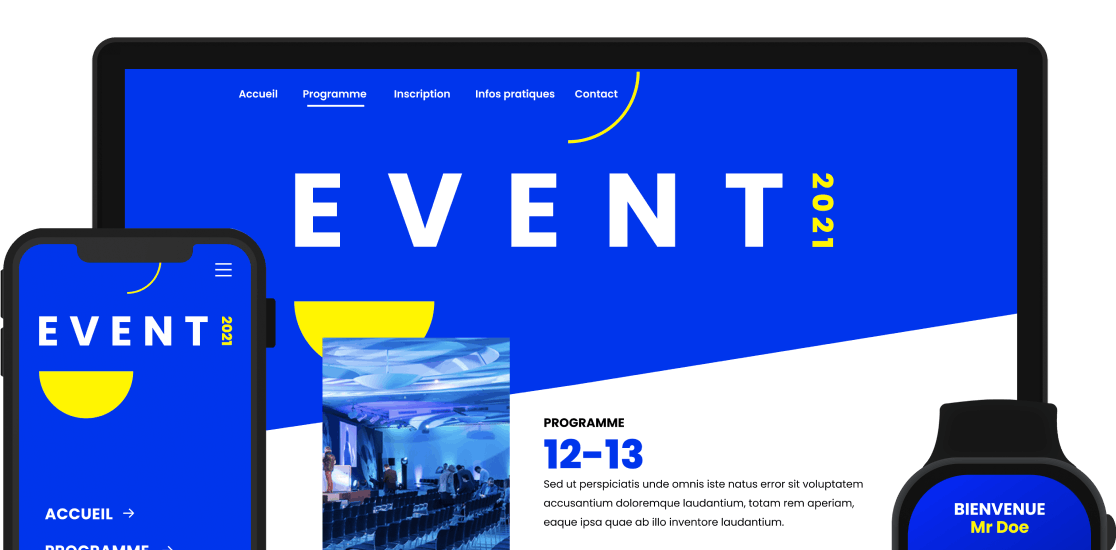Even with an exceptional event topic, the key metric of success or failure for a remote event remains the participation rate (and secondly, guest satisfaction...).
Certain tactics can help boost your participation rate, the following need to be executed before the event goes live:
- The relevance between the proposed contents and your audience
- The transfer of information from stakeholders
- The different strategies of "gifts" and promotional codes, to the "FOMO" strategies inherited from digital marketing
- Digital advertising on targeted audiences
- A/B testing, emailing, and its continuous optimization
- The timing of virtual events
- Add some fun to your virtual and hybrid events: SURPRISE your participants
- The design of the event website
- Networking: one of the best ways to engage with your attendees
- Preparing for the after-event - feedback and next steps
The relevance of the proposed contents to your audiences
Just as a whole is the sum of its parts, your potential audience is the sum of several smaller audiences (called segments).
These segments focus on different topics (and even, more specifically, on different subjects within those topics). During your events, whether they are physical or 100% virtual, always keep in mind the relationship between your content and the audience.
For this reason, your event should be the sum of different smaller topics. The more defined an event is, with a structure and a plan, the more your participants will be reassured and confident that they will get useful information out of it.
You can also (and this is the advantage of virtual) include experts from all over the world, to organize video conferences of exceptional quality and increase your awareness.
In fact, if you really want to make sure the audience is interested, create a survey to ask your participants about the topics and themes they would like to see throughout the event.
The transfer of information by all stakeholders
Your social networks and those of your speakers and sponsors represent a lot of potential visibility - still interested in sponsoring! If you have a blog or a company intranet, make sure to communicate all relevant information (Things of interest to your participants in order to attend your virtual/hybrid event - when to attend, where to register, which themes are addressed, which speakers?).
You will also need to take advantage of the notoriety of your external stakeholders: the more well-known your sponsors or speakers are, the stronger the exposure of your event will be and the more effective the co-branding will be.
Start by fine-tuning the description of your event announcement communication on social networks: visual (ask your graphic designer or use software such as Adobe Illustrator or Canva, Figma...).

Then write a description that should be in keeping with the tone of your company, while making the reader want to know more. We recommend that you write your text using the AIDA structure, which is well known in marketing:
- The A for Attention - capture your reader's attention in the first few lines (often by talking about a recurring problem they may encounter)
- The I of Interest - Show how your event will help solve his problem, and what interest your reader would have in registering.
- The D of Desire - Write with a touch of originality, something emotional or unusual about your subject, in order to create a differentiation in your communication.
- The A for Action - End by encouraging your reader to take action: often by providing a link to your event site.
This logical path, which builds on your attendees' problems while providing a solution (your event), helps convert more of your readers into attendees.
Once your post is written and published, don't hesitate to ask your sponsors and speakers to relay your message. They will usually be happy to do so without any compensation, as it also gives them good publicity at a lower cost.
The different strategies of "gifts" and the "FOMO"
Marketing and behavioral psychology are useful in many areas, especially when it comes to convincing people to take action.
One such marketing strategy is to offer gifts in the form of contests, to multiply the diffusion of your communication. If you have a small budget, try offerring attractive gifts or even coupons for discounts on your products and services.

Hold a drawing at your event to boost participation and retention of attendees at your event.
FOMO, an acronym for "Fear Of Missing Out," is the act of creating an urgency for people to do something or they might feel as though they missed out - such as a promotional code expiration date, a deadline for registration to your event, etc. - to make your event a success.
This technique can stimulate your prospects to take action and reserve their seats at your event (by the way, you only have until February 28th to subscribe to our newsletter).
Digital advertising on targeted audiences
If you have a communication budget for a major event, one way to attract new prospects is simply to sponsor keywords related to your event through an advertising campaign.
- For example, Google Ads proposes to highlight advertisements in search engines, depending on your budget.
This technique will undoubtedly bring you an audience and will eventually generate leads, but it is up to you to choose the right keywords to ensure the quality of the audience that will see your ads.

- You can also tap into professional networks such as LinkedIn, which can be more relevant if your event is about a professional subject.
Even on LinkedIn, you have ways to create a sponsored post about your event: you can set up this post to reach only certain people in certain positions of responsibility, in certain sectors.
- Possibilities also exist on Facebook and Instagram (which offer a rather precise choice of an audience).
Don't hesitate to explore the channel on which your audience is most connected, but don't spread yourself, trying to "be everywhere".
A/B testing, emailing, and continuous optimization
A/B testing is a way of optimizing your communications to try two approaches (A and B) and keep the one that is the most efficient.
There are several ways to use A/B testing in your event actions: prepare several groups of audiences and send a different email to each one (the subject can be different, the approach can be different, the image can be different...). You will then have to observe the results, then send the email with the best statistics to your entire segment.
This technique allows you to test your communications on smaller portions of the audience, limiting the risk of "flopping."
As you navigate through the different events, you will naturally develop the ability to be more and more targeted in your communications, which will have a significant impact on your participation rate.
Your launch emailing must follow an A/B testing plan, as we have seen. But how do you prepare a good invitation email to maximize your participation rate?

Imagine that every email you send is a little salesman promoting your event: what would his catchphrase be? The subject line of your email should match the catchphrase: it should make you want to click on the email.
Test the subject on your colleagues and on some small segments of your audience. Do the same for the illustration image (if you don't have one, it's always better to create one - with Canva for example).
For the body text, it is essential that it includes the purpose of the event, the query your virtual event will solve for your participants, the program, the speakers, and a call to action (a registration button for example). Sometimes add a few touches of mystery, such as a surprise guest that you will only reveal during the event, to peak your reader's curiosity.
If you're worried about making mistakes in your email, check your email for any of the 14 emailing errors we've listed for you.
Remember the more your email is developed and on point, the more your visitors will sign up.
The timing of virtual events
On which day and time should I make my virtual event?
This is a major problem that every event organizer knows.
This question can totally change your participation rate, we have several recommendations:
- Survey your audience by asking them which time slot would be more convenient: give them two or three options.
- You should also think about the schedule and typologies of your guests: experienced entrepreneurs do not have the same schedule as young parents. So put yourself in your audience's shoes and do things in their best interest.
- Think about the time difference, and prioritize the end-of-day schedule of the audience you want to address first.
- If possible, organize your events at the beginning or end of the week, to avoid being in a day where files are piling up for your clients, and where your event will be secondary to the emergencies to be dealt with.
The Wow factor
We can't say it often enough: creating fun moments into a virtual or hybrid event ensures that participants will be more attentive and invested.

Below are a few tips, and you can also find the complete list to keep your attendees engaged at your events.
- Reach out to speakers out of your normal cirlce: Never hesitate to invite a speaker who is outside your company's normal domain. They can bring their own vision of the topic to your virtual event.
- Organize role-play games, even digitally: Don't hesitate to use interaction solutions, games, and quizzes on the content of your event. The advantage is twofold. Your attendees feel invested and don't want to be "left on the sidelines" while everyone is participating. Nobody likes to be last!
- Invite an actor for a quick sketch (even via video, good comedians are funny and can make jokes about any subjet) around your theme. There are even English- speaking comedians who specialize in energizing corporate events.
The design of the event site
Your event website is the last step in the process. It will be used to host your event, but also to communicate about it. The website is the real virtual showcase of your event, the catalyst of information.
You must therefore pay particular attention to applying a well-thought-out design (often by an artistic direction, graphic designers...). You must also make sure that it is fully compatible with different screen sizes: from smartphones to large 15-inch screens.
Though Digitevent will allow you to succeed in all these aspects, you should still have your website proof-read by colleagues to make sure that the experience is pleasant and that the background information is relevant.

The website should also contain a menu with clear and impactful headings, such as the program, speakers, link to the registration form, or practical information.
If you are not confident in your tech abilities, we have developed an intuitive site creation tool that will allow you to easily create the event website of your dreams.
Networking: one of the best ways to make your participants engaged
Your visitors register for your event for one of these two reasons:
- They think they will gain something: relevant content, a new approach, or tools that will help them to solve their problems.
- They can expand their network and create new professional relationships, which can bring them business opportunities.
This second point is quite fundamental for your event. If your event is designed to address this second issue, you should plan matchmaking sessions between your participants.
By doing so, you allow them to stop being mere spectators of your event -and take an active role in it!
Useful to dozens of different types of events, this appointment scheduling module makes your attendee independent and increases the added value of your digital event.
Preparing for the post-event: feedback and future event dates
You can, even before your virtual or hybrid event, think about how you will collect feedback and data.
You can schedule an automatic email a few hours after the event, to receive your guest's insights, what they would like to see at future events, etc...
It is customary (if you have enough visibility) to communicate your next event dates or your company's next news.
We hope that this guide helped you clarify best practices to apply in your future events.
We sincerely hope that it will help you turn more visitors into participants at your virtual and hybrid events.



